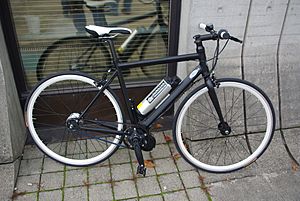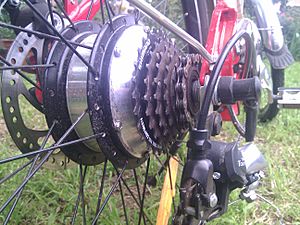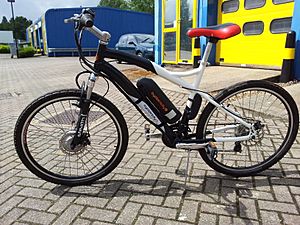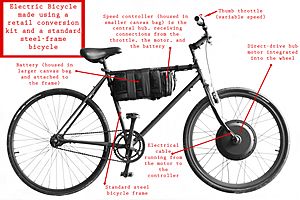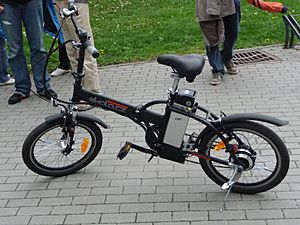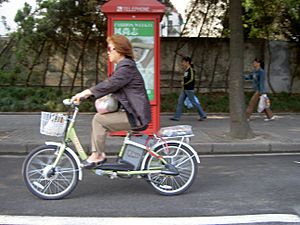Electric bicycle facts for kids
An electric bicycle is a bicycle that uses electricity as its power. These bikes do not pollute the air. Usually a biker can control how much the motor helps. For example, it can be 50% of the force needed. These kinds of bikes have become more popular. In some cases it is possible to convert a traditional bike to electric using a conversion kit.
Contents
Popularity
E-bike usage worldwide has experienced rapid growth since 1998. In 2016 there were 210 million electric bikes worldwide used daily. It is estimated that there were roughly 120 million e-bikes in China in early 2010, and sales are expanding rapidly in India, the United States of America, Germany, the Netherlands, and Switzerland. A total of 700,000 e-bikes were sold in Europe in 2010, up from 200,000 in 2007 and 500,000 units in 2009.
Today, China is the world's leading producer of e-bikes. According to the data of the China Bicycle Association, a government-chartered industry group, in 2004 China's manufacturers sold 7.5 million e-bikes nationwide, which was almost twice the year 2003 sales; domestic sales reached 10 million in 2005, and 16 to 18 million in 2006.
Technical
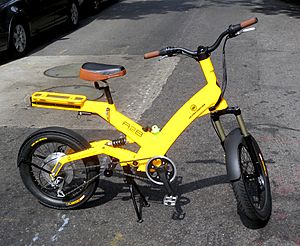
Motors and drivetrains
The two most common types of hub motors used in electric bicycles are brushed and brushless. There are many possible types of electric motorized bicycles with several technologies available, varying in cost and complexity; direct-drive and geared motor units are both used. An electric power-assist system may be added to almost any pedal cycle using chain drive, belt drive, hub motors or friction drive. BLDC hub motors are a common modern design with the motor built into the wheel hub itself and the stator fixed solidly to the axle and the magnets attached to and rotating with the wheel. The bicycle wheel hub is the motor. The power levels of motors used are influenced by available legal categories and are often, but not always limited to under 750 watts.
Another type of electric assist motor, often referred to as the mid-drive system, is increasing in popularity. With this system, the electric motor is not built into the wheel but is usually mounted near (often under) the bottom bracket shell. In more typical configurations, a cog or wheel on the motor drives a belt or chain that engages with a pulley or sprocket fixed to one of the arms of the bicycle's crankset. Thus the propulsion is provided at the pedals rather than at the wheel, being eventually applied to the wheel via the bicycle's standard drive train.
Batteries
E-bikes use rechargeable batteries, electric motors and some form of control. Battery systems in use include sealed lead-acid (SLA), nickel-cadmium (NiCad), nickel-metal hydride (NiMH) or lithium-ion polymer (Li-ion). Batteries vary according to the voltage, total charge capacity (amp hours), weight, the number of charging cycles before performance degrades, and ability to handle over-voltage charging conditions. The energy costs of operating e-bikes are small, but there can be considerable battery replacement costs. The lifespan of a battery pack varies depends on the type of usage. Shallow discharge/recharge cycles will help extend the overall battery life.
Range is a key consideration with e-bikes, and is affected by factors such as motor efficiency, battery capacity, efficiency of the driving electronics, aerodynamics, hills and weight of the bike and rider. Some manufacturers, such as the Canadian BionX or American E+ (manufactured by Electric Motion Systems), have the option of using regenerative braking, the motor acts as a generator to slow the bike down prior to the brake pads engaging. This is useful for extending the range and the life of brake pads and wheel rims. There are also experiments using fuel cells. e.g. the PHB. Some experiments have also been undertaken with super capacitors to supplement or replace batteries for cars and some SUVS. E-bikes developed in Switzerland in the late 1980s for the Tour de Sol solar vehicle race came with solar charging stations but these were later fixed on roofs and connected so as to feed into the electric mains. The bicycles were then charged from the mains, as is common today. While ebike batteries were produced mainly by bigger companies in past, many small to medium companies have started using innovative new methods for creating more durable batteries. State of the art, custom built automated precision CNC spot welding machines created 18650 battery packs are commonly used among Do-it-yourself ebike makers.
Controllers
There are two distinct types of controllers designed to match either a brushed motor or brushless motor. Brushless motors are becoming more common as the cost of controllers continues to decrease. (See the page on DC motors which covers the differences between these two types.)
Controllers for brushless motors: E-bikes require high initial torque and therefore models that use brushless motors typically have Hall sensor commutation for speed and angle measurement. An electronic controller provides assistance as a function of the sensor inputs, the vehicle speed and the required force. The controllers generally allow input by means of potentiometer or Hall Effect twist grip (or thumb-operated lever throttle), closed-loop speed control for precise speed regulation, protection logic for over-voltage, over-current and thermal protection. Bikes with a pedal assist function typically have a disc on the crank shaft featuring a ring of magnets coupled with a Hall sensor giving rise to a series of pulses, the frequency of which is proportional to pedaling speed. The controller uses pulse width modulation to regulate the power to the motor. Sometimes support is provided for regenerative braking but infrequent braking and the low mass of bicycles limits recovered energy. An implementation is described in an application note for a 200 W, 24 V Brushless DC (BLDC) motor.
Controllers for brushed motors: Brushed motors are also used in e-bikes but are becoming less common due to their intrinsic lower efficiency. Controllers for brushed motors however are much simpler and cheaper due to the fact they don't require hall sensor feedback and are typically designed to be open-loop controllers. Some controllers can handle multiple voltages.
Design variations
Not all e-bikes take the form of conventional push-bikes with an incorporated motor, such as the Cytronex bicycles which use a small battery disguised as a water bottle. Some are designed to take the appearance of low capacity motorcycles, but smaller in size and consisting of an electric motor rather than a petrol engine. For example, the Sakura e-bike incorporates a 200 W motor found on standard e-bikes, but also includes plastic cladding, front and rear lights, and a speedometer. It is styled as a modern moped, and is often mistaken for one.
Converting a non-electric bicycle to its electric equivalent can be complicated but numerous 'replace a wheel' solutions are now available on the market.
Rear wheel solutions include: FlyKly and Superpedestrian.
Front wheel solutions include: EVELO Omni Wheel and GeoOrbital
An Electric Pusher Trailer is an e-bike design which incorporates a motor and battery into a trailer that pushes any bicycle. One such trailer is the two-wheeled Ridekick.
Other, rarer designs include that of a 'chopper' styled e-bike, which are designed as more of a 'fun' or 'novelty' e-bike than as a purposeful mobility aid or mode of transport.
Electric cargo bikes allow the rider to carry large, heavy items which would be difficult to transport without electric power supplementing the human power input.
Various designs (including those mentioned above) are designed to fit inside most area laws, and the ones that contain pedals can be used on roads in the United Kingdom, among other countries.
Folding e-bikes are also available.
Electric self-balancing unicycles do not conform to e-bike legislation in most countries and therefore cannot be used on the road, but can be utilized in the sidewalk. They are the cheapest electric cycles and used by the last mile commuters, for urban use and to be combined with public transport, including buses.
Tricycles
Electric trikes have also been produced that conform to the e-bike legislation. These have the benefit of additional low speed stability and are often favored by people with disabilities. Cargo carrying tricycles are also gaining acceptance, with a small but growing number of couriers using them for package deliveries in city centres. Latest designs of these trikes resemble a cross-between a pedal cycle and a small van.
Health benefits
E-bikes can be a useful part of cardiac rehabilitation programmes, since health professionals will often recommend a stationary bike be used in the early stages of these. Exercise-based cardiac rehabilitation programmes can reduce deaths in people with coronary heart disease by around 27%; and a patient may feel safer progressing from stationary bikes to e-bikes. They require less cardiac exertion for those who have experienced heart problems.
E-bikes can also provide a source of exercise for individuals who have trouble exercising for an extended time (due to injury or excessive weight, for example) as the bike can allow the rider to take short breaks from pedaling and also provide confidence to the rider that they'll be able to complete the selected path without becoming too fatigued.
Some individuals have lost considerable amounts of weight by using an electric bike. By making the biking terrain less of an issue, people who wouldn't otherwise consider biking can use the electric assistance when needed and otherwise pedal as they are able.
Environmental effects
E-bikes are zero-emissions vehicles, as they emit no combustion by-products. However, the environmental effects of electricity generation and power distribution and of manufacturing and disposing of (limited life) high storage density batteries must be taken into account. Even with these issues considered, e-bikes are claimed to have a significantly lower environmental impact than conventional automobiles, and are generally seen as environmentally desirable in an urban environment.
The environmental effects involved in recharging the batteries can of course be minimised. The small size of the battery pack on an e-bike, relative to the larger pack used in an electric car, makes them very good candidates for charging via solar power or other renewable energy resources. Sanyo capitalized on this benefit when it set up "solar parking lots," in which e-bike riders can charge their vehicles while parked under photovoltaic panels.
The environmental credentials of e-bikes, and electric / human powered hybrids generally, have led some municipal authorities to use them, such as Little Rock, Arkansas with their Wavecrest electric power-assisted bicycles or Cloverdale, California police with Zap e-bikes. China’s e-bike manufacturers, such as Xinri, are now partnering with universities in a bid to improve their technology in line with international environmental standards, backed by the Chinese government who is keen to improve the export potential of the Chinese manufactured e-bikes.
Both land management regulators and mountain bike trail access advocates have argued for bans of electric bicycles on outdoor trails that are accessible to mountain bikes, citing potential safety hazards as well as the potential for electric bikes to damage trails. A study conducted by the International Mountain Bicycling Association, however, found that the physical impacts of low-powered pedal-assist electric mountain bikes may be similar to traditional mountain bikes.
A recent study on the environment impact of e-bikes vs other forms of transportation found that e-bikes are:
- 18 times more energy efficient than an SUV
- 13 times more energy efficient than a sedan
- 6 times more energy efficient than rail transit
- and, of about equal impact to the environment as a conventional bicycle.
One major concern is disposal of used lead batteries, which can cause environmental contamination if not recycled.
There are strict shipping regulations for lithium-ion batteries, due to safety concerns. In this regard, lithium iron phosphate batteries are safer than lithium cobalt oxide batteries.
Road traffic safety
China's experience, as the leading e-bike world market, has raised concerns about road traffic safety and several cities have considered banning them from bicycle lanes. As the number of e-bikes increased and more powerful motors are used, capable of reaching up to 30 miles per hour (48 km/h), the number of traffic accidents have risen significantly in China. E-bike riders are more likely than a car driver to be killed or injured in a collision, and because e-bikers use conventional bicycle lanes they mix with slower-moving bicycles and pedestrians, increasing the risk of traffic collisions.
Experience by country
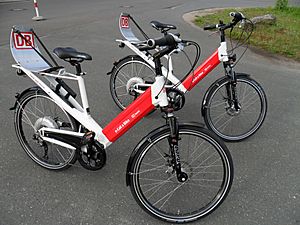
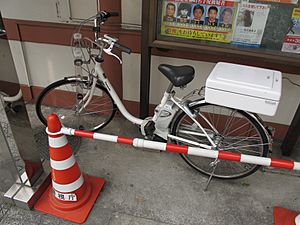
China
China has experienced an explosive growth of sales of non-assisted e-bikes including scooter type, with annual sales jumping from 56,000 units in 1998 to over 21 million in 2008, and reaching an estimated fleet of 120 million e-bikes in early 2010. This boom was triggered by Chinese local governments' efforts to restrict motorcycles in city centers to avoid traffic disruption and accidents. By late 2009 motorcycles are banned or restricted in over ninety major Chinese cities. Users began replacing traditional bicycles and motorcycles and, in e-bike became an alternative to commuting by car. Nevertheless, road safety concerns continue as around 2,500 e-bike related deaths were registered in 2007. By late 2009 ten cities had also banned or imposed restrictions on e-bikes on the same grounds as motorcycles. Among these cities were Guangzhou, Shenzhen, Changsha, Foshan, Changzhou, and Dongguang.
China is the world's leading manufacturer of e-bikes, with 22.2 million units produced in 2009. One of the biggest manufacturers of E-bikes in the world is Geoby. Production is concentrated in five regions, Tianjin, Zhejiang, Jiangsu, Shandong, and Shanghai. China exported 370,000 e-bikes in 2009.
India
The first pedal-assisted bicycles appeared in India in 1993. In 2008, the sales of e-bike sales exceeded moped sales. In recent years, 2-passenger and even 3-passenger (two adults and a child) e-bikes were introduced in India.
Netherlands
The Netherlands has a fleet of 18 million bicycles. E-bikes have reached a market share of 10% by 2009, as e-bikes sales quadrupled from 40,000 units to 153,000 between 2006 and 2009, and the electric-powered models represented 25% of the total bicycle sales revenue in that year. By early 2010 one in every eight bicycles sold in the country is electric-powered despite the fact that on average an e-bike is three times more expensive than a regular bicycle.
A 2008 market survey showed that the average distance traveled in the Netherlands by commuters on a standard bicycle is 6.3 kilometres (3.9 mi) while with an e-bike this distance increases to 9.8 kilometres (6.1 mi). This survey also showed that e-bike ownership is particularly popular among people aged 65 and over, but limited among commuters. The e-bike is used in particular for recreational bicycle trips, shopping and errands.
United States
In 2009 the U.S. had an estimated fleet of 200,000 e-bikes. In 2012 they were increasingly favored in New York as food delivery vehicles.
In 2012, two e-bike advocates completed the first 4,000-mile (6,400 km) transcontinental e-bike tour from New York to San Francisco to advocate for e-bikes in major cities across the U.S. Pedego Electric Bikes is the best selling brand in the U.S. Many e-bikes in the United States are standard bicycles converted using a kit. In general, the kits include the motor (the majority of which are hub motors built into the front or rear wheel), a speed controller, throttle (usually twist-grip or thumb throttle), necessary wiring and connectors, and a battery. Several U.S. companies offer conversion kits which also offer advanced lithium battery packs. Major manufacturers also offer complete e-bikes. Trek offers a line of e-bikes using the Bionx system in which the rider programs the controller to determine how much effort the motor will give in response to rider effort, from 25% up to 200% of the rider's power. This system ensures a minimum level of rider participation and is also used to comply with many European laws mandating partial human effort before the motor engages.
One of the biggest headwinds facing electric bicycles in the United States has been lower gas prices.
Images for kids
-
E-bikes and electric scooters in a specialized shop in Beijing in 2008. (Y2750 is around US$400)
-
E-bikes are common in China, with an estimated fleet of 120 million in early 2010.
See also
 In Spanish: Bicicleta eléctrica para niños
In Spanish: Bicicleta eléctrica para niños


